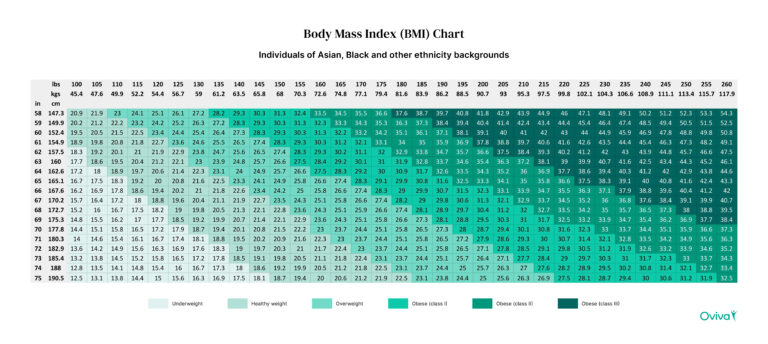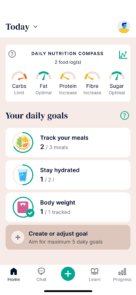
Am I overweight? Calculate your body mass index
Calculating your body mass index (BMI) helps you understand whether your weight could impact your health, for example, if you’re overweight, obese, or underweight. All of these come with health risks.
BMI is a metric that uses weight and height to estimate body fat. It can provide a generalised guide to whether you’re underweight, overweight, obese, or in the healthy weight range. If you are living with obesity, a medically supervised weight loss programme like Oviva’s could help you.
Key Takeaways
- Body mass index (BMI) is a useful metric for estimating body fat and determining whether you’re at an elevated risk of health issues based on your weight.
- You can calculate your BMI using our free online BMI calculator.
- If you have a BMI of 25 and above, you’re classed as overweight. If you have a BMI of 35 and above, you’re classed as living with obesity.
- If you have a BMI of 35 and above and relevant weight-related health conditions, you may be eligible for Oviva, an NHS-funded weight management service.
How do I know if I’m overweight?
One of the best ways to determine whether you’re overweight is to measure your body weight and height and use this information to calculate your body mass index (BMI). Your BMI will indicate whether you fall into a healthy weight range or have an elevated risk of health issues related to your weight.
If you want to know how to check if you are overweight, you can use our BMI calculator to calculate your BMI quickly and accurately. You’ll need to know both your height and weight.
Body mass index (BMI) ranges in the UK
When calculating your BMI, you’ll receive a BMI score. It’s usually just a number, but it’s expressed in kg/m2. So, an online BMI calculator or a healthcare professional may tell you your BMI is 30 rather than 30 kg/m2.
To determine risk concerning body weight, the NHS breaks down BMI scores into ranges, which indicate being underweight, overweight, obese, or in the healthy weight range.
BMI ranges vary depending on your ethnic background. That’s because research has shown that some people face an increased risk of health conditions, like type 2 diabetes or heart disease, at a lower BMI.
If you’re from a White background, BMI ranges in the UK are as follows:
- Under 18.5: this is classed as underweight.
- 18.5 to 24.9: this is the healthy weight range.
- 25 to 29.9: this is classed as overweight.
- 30 and above: this is classed as obese.

If you’re from an Asian, African-Caribbean, Black African or Middle Eastern ethnic family background, your BMI thresholds are:
- 18.5 to 22.9: this is the healthy weight range.
- 23 to 27.4: this is classed as overweight.
- 27.5 and above: this is classed as obese.


BMI class I, II and III of obesity explained
The obese range of the UK BMI scale is divided into three classes, which are as follows:
- Class I – BMI of 30 to 34.9: classed as low-risk obesity.
- Class II – BMI of 35 to 39.9: classed as moderate-risk obesity.
- Class III – BMI of 40+: classed as high-risk obesity.
For ethnic minorities, these thresholds are:
- Class I – BMI of 27.5 to 32.4: classed as low-risk obesity.
- Class II – BMI of 32.5 to 37.4: classed as moderate-risk obesity.
- Class III – BMI of 37.5+: classed as high-risk obesity.
Learn more about the various treatments for obesity in the UK.
Free body mass index (BMI) calculator
The easiest way to calculate your body mass index is to use an online BMI calculator. You’ll quickly learn what your BMI is and what BMI range you’re in. This will then help you to know whether you’re overweight or classed as living with obesity.
Calculate your BMI online for free here:
Below 18.5
You’re in the underweight range. It’s advisable to consult a healthcare professional to discuss your weight and receive personalised guidance on improving your nutritional intake.
You’re in the healthy weight range. Continue to maintain a balanced diet and regular physical activity to stay in this healthy range.
If you have an Asian, Chinese, Middle Eastern, Black African or African-Caribbean family background and your BMI is 23 or over, you’re in the overweight range.
You’re in the overweight range. Consider speaking with a healthcare provider to explore strategies for weight management and assess if any underlying health issues need attention.
If you have an Asian, Chinese, Middle Eastern, Black African or African-Caribbean family background and your BMI is 27.5 or over, you’re in the obese range and Oviva’s weight management programme could help. Speak to your GP to check your eligibility and receive tailored support.
You’re in the obese range. This BMI category may increase your risk of various health conditions.
Oviva’s weight management programme could help if you have a pre-existing medical condition such as heart disease, asthma or type 2 diabetes. Speak to your GP to check your eligibility and receive tailored support.
Your BMI indicates severe obesity, which can significantly impact your health.
Oviva’s weight management programme could help. Speak to your GP to check your eligibility and receive tailored support.
Your BMI indicates severe obesity, which can significantly impact your health.
Oviva’s weight management programme could help. Speak to your GP to check your eligibility and receive tailored support.
Below 18.5
You’re in the underweight range. It’s advisable to consult a healthcare professional to discuss your weight and receive personalised guidance on improving your nutritional intake.
You’re in the healthy weight range. Continue to maintain a balanced diet and regular physical activity to stay in this healthy range.
You’re in the overweight range. Consider speaking with a healthcare provider to explore strategies for weight management and assess if any underlying health issues need attention.
You’re in the obese range. This BMI category may increase your risk of various health conditions.
Oviva’s weight management programme could help if you have a pre-existing medical condition such as heart disease, asthma or type 2 diabetes. Speak to your GP to check your eligibility and receive tailored support.
Your BMI indicates severe obesity, which can significantly impact your health.
Oviva’s weight management programme could help if you have a pre-existing medical condition such as heart disease, asthma or type 2 diabetes. Speak to your GP to check your eligibility and receive tailored support.
Your BMI indicates severe obesity, which can significantly impact your health.
Oviva’s weight management programme could help. Speak to your GP to check your eligibility and receive tailored support.
If you have a BMI over 35 and have at least one relevant comorbidity, you may be eligible for Oviva’s programme. Comorbidities include:
- Asthma
- High blood pressure
- Type 2 diabetes
- Pre-diabetes
- Heart disease
- Acid reflux
- Depression
- Polycystic ovary syndrome (PCOS)
- Sleep apnoea
Oviva patient success stories:

 -22kg
-22kg
Heidi (53)

 -25kg
-25kg
Martin (34)

 -32kg
-32kg
Patricia (53)
How to calculate BMI for obesity
Body mass index is calculated by using weight and height to estimate body fat. It follows this formula:
BMI = weight (in kilogrammes) / height (in metres)2
So, to calculate your BMI, you need to know your weight in kilogrammes (e.g., 100 kg).
You also need to know your height in metres (e.g., 175 cm would be 1.75 m). You can use an online conversion tool if you know your height in feet and inches.
To perform the calculation, you should take your height and square it (multiply it by itself). So if your height is 1.75 m, your height squared would be 1.75 x 1.75 = 3.0625.
You would then take your weight and divide it by your height squared.
The result is your BMI.
In our example, this would be 100 / 3.0625 = 32.65. This would then be rounded up to a BMI of 33, which would place the person in the Class I obesity range.
BMI and obesity FAQs
Find answers to some of the most commonly asked questions about the relationship between body mass index (BMI) and obesity.

How does ethnicity influence obesity?
Your ethnicity does not influence your BMI calculation but will affect how your BMI score is interpreted.
People from Asian, African-Caribbean, Black African, and Middle Eastern ethnic family backgrounds have a higher chance of developing weight-related health problems at a lower BMI, which is why many BMI calculators ask for your ethnicity.
For people from these backgrounds, being overweight is classed as a BMI of 23 and above instead of 25, while the threshold for living with obesity is 27.5 instead of 30.
Am I overweight for my age?
Aside from the measurement of BMI in children, BMI does not factor age into the equation. If you’re over 18 and classed as overweight according to BMI thresholds, the classification applies regardless of age.
What is the recommended weight for my height?
The best way to check the recommended weight for your height using the BMI metric is to check a body mass index chart. This will tell you the range of weights considered ideal for your height and the range of weights classed as underweight, overweight and obese.
How accurate is BMI for obesity?
BMI is just one measure of obesity. It’s useful for most people but not accurate for everyone. For instance, using weight to determine body fat is somewhat flawed because BMI cannot differentiate between body fat and muscle.
For this reason, if you’re very muscular, you may present as overweight or obese, even if you have a relatively low body fat percentage.
Other options are available, such as waist-to-height ratio and waist circumference. These factors are based on your waist size, a crucial difference from BMI, which only factors in weight and height. Nevertheless, BMI is convenient, widely used, and easily understood.

How Oviva supports people living with obesity
Oviva offers a weight management programme covered by the NHS. This service is designed to assist people living with obesity in making changes that can reduce health risks. Our expert team includes doctors, nurses, psychologists, and dietitians.
If you have a BMI over 35 and have a relevant weight-related health condition, you can seek a referral to the Oviva service. If you’re eligible, you’ll receive expert support and personalised online care through the Oviva app as you implement lifestyle changes concerning nutrition and exercise.
You may also receive prescription weight loss medication, such as Wegovy, as part of your treatment. This should be taken in combination with lifestyle changes to promote sustainable weight loss.








